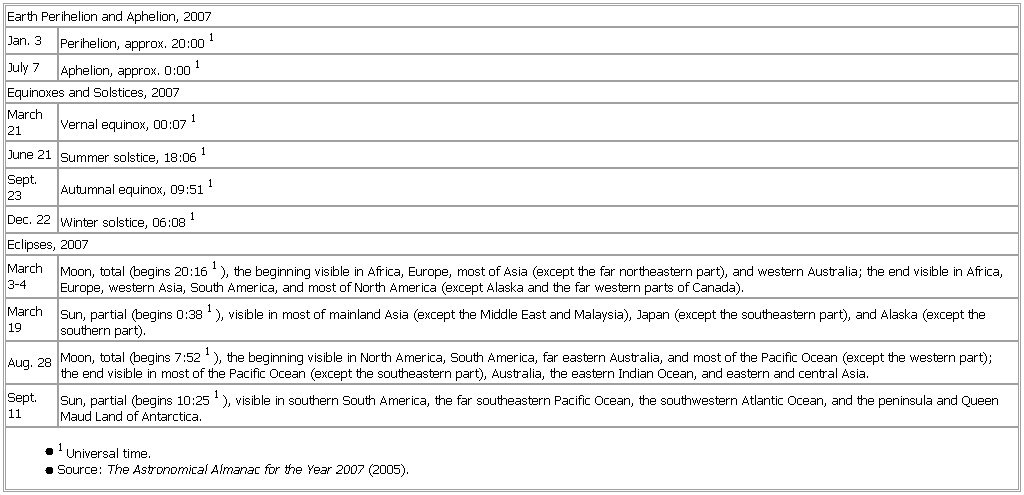Earth Perihelion and Aphelion, 2007
- Earth Perihelion and Aphelion, 2007
-
Earth Perihelion and Aphelion, 2007
Jan. 3 Perihelion, approx. 20:001
July 7 Aphelion, approx. 0:001
Equinoxes and Solstices, 2007
March 21 Vernal equinox, 00:071
June 21 Summer solstice, 18:061
Sept. 23 Autumnal equinox, 09:511
Dec. 22 Winter solstice, 06:081
Eclipses, 2007
March 3-
4 Moon,
total (
begins 20:161),
the beginning visible in Africa,
Europe,
most of Asia (
except the far northeastern part),
and western Australia;
the end visible in Africa,
Europe,
western Asia,
South America,
and most of North America (
except Alaska and the far western parts of Canada).
March 19 Sun,
partial (
begins 0:381),
visible in most of mainland Asia (
except the Middle East and Malaysia),
Japan (
except the southeastern part),
and Alaska (
except the southern part).
Aug.
28 Moon,
total (
begins 7:521),
the beginning visible in North America,
South America,
far eastern Australia,
and most of the Pacific Ocean (
except the western part);
the end visible in most of the Pacific Ocean (
except the southeastern part),
Australia,
the eastern Indian Ocean,
and eastern and central Asia.
Sept. 11 Sun, partial (begins 10:251), visible in southern South America, the far southeastern Pacific Ocean, the southwestern Atlantic Ocean, and the peninsula and Queen Maud Land of Antarctica.
● 1Universal time.
● Source: The Astronomical Almanac for the Year 2007 (2005).
See as table:
* * *
Universalium.
2010.
Look at other dictionaries:
Earth Perihelion and Aphelion, 2009 — ▪ Table Earth Perihelion and Aphelion, 2009 Jan. 4 Perihelion, approx. 15:001 July 4 Aphelion, approx. 02:001 Equinoxes and Solstices, 2009 March 20 Vernal equinox, 11:441 June 21 Summer solstice, 05:461 Sept. 22 Autumnal equinox, 21:191 Dec. 21… … Universalium
Earth — This article is about the planet. For other uses, see Earth (disambiguation). Earth … Wikipedia
Earth's orbit — In astronomy, The Earth s Orbit involves the Earth orbiting the Sun at an average distance of about 150 million kilometers every 365.2564 mean solar days (1 sidereal year). From Earth, this gives an apparent movement of the Sun with respect to… … Wikipedia
2007 WD5 — Minor Planet name=mp|2007 WD|5 discoverer= Andrea Boattini discovery date=November 202007 designations= none category=Apollo asteroid, Mars crosser asteroid epoch=April 10, 2007 semimajor= 2.541 AU perihelion= 1.01016 AU aphelion= 4.072 AU… … Wikipedia
2007 CA19 — Minor Planet name=mp|2007 CA|19 discoverer=Catalina Sky Survey discovery date=February 11, 2007 designations= none category=Apollo asteroid, Earth crosser asteroid Mars crosser asteroid epoch=April 10, 2007 (MJD 54200) semimajor= 2.03517 AU… … Wikipedia
2007 McCuskey — Discovery Discovered by Indiana Asteroid Program Discovery date September 22, 1963 Designations Alternate name(s) A921 EK; 1936 HP; … Wikipedia
2007 TU24 — Infobox Planet minorplanet=yes name=mp|2007 TU|24 discovery=yes discoverer=Catalina Sky Survey discovered=October 11, 2007 designations= none mp category=Apollo asteroid, Earth crosser asteroid epoch=February 4, 2008 semimajor=2.044 AU perihelion … Wikipedia
2007 VK184 — Infobox Planet | discovery=yes | physical characteristics = yes | bgcolour=#FFFFC0 name=2007 VK184 discoverer=Catalina Sky Survey discovered=November 11, 2007 alt names= mp category=Apollo orbit ref = cite web |title =JPL Small Body Database… … Wikipedia
Near-Earth object — Asteroid 4179 Toutatis is a potentially hazardous object that has passed within 2.3 lunar distances … Wikipedia
Physical Sciences — ▪ 2009 Introduction Scientists discovered a new family of superconducting materials and obtained unique images of individual hydrogen atoms and of a multiple exoplanet system. Europe completed the Large Hadron Collider, and China and India took… … Universalium

